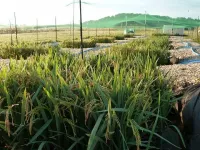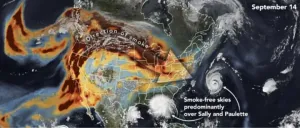(Press-News.org) When most people hear "food contamination," they think of bacteria present on unwashed fruits or vegetables, or undercooked meat. However, there are other ways for harmful contaminants to be present in food products.
Angelia Seyfferth, a member of the Soil Science Society of America, investigates food contamination coming from the soil where the plants grow. "It all comes down to the chemistry of the soil," explains Seyfferth.
Most recently, Seyfferth has been studying rice. The elements arsenic and cadmium can be present in the paddies where rice is grown. She presented her research at the virtual 2020 ASA-CSSA-SSSA Annual Meeting.
"Contaminants being taken up by crop plants is a route of dietary exposure to contaminants that is understudied," Seyfferth says. "We can help decrease human exposure to toxins by applying our knowledge of soil chemistry."
Small amounts of arsenic and cadmium are present all over the globe and can be detected in many food products. It's the concentration in the vegetable or fruit, the chemical form of the element, and how much of it someone eats that determines if an individual experiences a negative health effect.
High concentrations of arsenic and cadmium are harmful to the body. Consuming low doses over a long period of time can even cause cancer.
Elements like arsenic and cadmium can be in different chemical forms depending on their environment. Contaminants are taken up by plants when their chemical form in the soil resembles a nutrient the plant needs.
"How food is grown affects not only the concentration of contaminants, but also where the contaminants are stored within the food," says Seyfferth. "If we understand the chemical forms of contaminants in soil, we can design solutions to decrease plant uptake of them."
In rice, arsenic and cadmium uptake results from opposite conditions. Arsenic can be taken up when the field is flooded. Cadmium is more likely to be taken up when the field is not flooded.
Seyfferth's work has searched for a way to prevent plants from taking up arsenic and cadmium from the soil. This is often done by adding materials to the soil, called amendments.
An amendment helps change the soil environment. By changing the soil environment, researchers can help control the chemical forms and plant uptake of contaminants in the soil.
In this case, Seyfferth found that adding rice husk residue to rice paddy soils can help lower the amount of arsenic and cadmium taken up by the plants. Rice husk residue is plant material left over after processing rice for human consumption.
This solution is simple yet effective. Rice husk residue is high in the element silicon, which is an important nutrient for rice. The chemical form of silicon is similar to the form of arsenic taken up by rice plants when fields are flooded. This similarity helps 'distract' the plant, which prevents it from taking up as much arsenic.
In soils where cadmium is a problem, rice husk residue helps make the soil less acidic. This helps to lock up cadmium in the soil. The silicon in the husk may also help decrease the toxicity of cadmium.
"Not all sources of silicon behave the same way though," says Seyfferth. "In order for it to be effective, the silicon source must provide silicon in a high enough concentration during the time the rice plant is filling grain. Rice husk residue is a successful source because it breaks down slowly and releases silicon throughout the growing season."
High arsenic can decrease grain yield, but Seyfferth's work shows that adding rice husk residues can help prevent yield loss. Half of the world depends on rice as a staple food, so this research has exciting potential for positive impact.
In the past, Seyfferth has studied similar contamination issues in mushrooms.
For most American adults, the amount of arsenic and cadmium they consume from rice and mushrooms is not enough to cause concern. But there are other populations that eat these products more frequently and from an early age.
"People need to be aware of their daily load of contaminants, which depends on their body weight, the concentration and chemical form of the contaminant in the food, and the amount consumed," Seyfferth explains.
"The daily load is highest for people who consume rice multiple times a day and who may also have arsenic in their drinking water," she says. "Some examples include populations in South and Southeast Asia."
Angelia Seyfferth is an associate professor at the University of Delaware. This work was supported by the National Science Foundation, the National Institute of Food and Agriculture, and the University of Delaware. The 2020 ASA-CSSA-SSSA Annual Meeting was hosted by the American Society of Agronomy, Crop Science Society of America, and Soil Science Society of America.
INFORMATION:
American Society of Agronomy, Soil Science Society of America, Crop Science Society of America: Collectively, these Societies represent more than 12,000 individual members around the world. Members are researchers and professionals in the areas of growing our world's food supply while protecting our environment. Together we work toward solutions to advance scientific knowledge in the areas of agronomy, crop science, and soil science.
Twitter: @ASA_CSSA_SSSA & @SSSA_soils | Facebook: ASA, CSSA & SSSA | Instagram: @sustainablefoodsupply & @iheartsoil
Study using surveys of more than 1.1 million 13-15-year-olds from 140 countries between 1999 and 2018, finds that the prevalence of smoking cigarettes on at least one day during the past 30 days decreased in 80 countries (57%) but was unchanged or increased in 60 countries (43%).
However, during the same time period, the prevalence of using other tobacco products, such as chewing tobacco, snuff, dip, cigars, cigarillos, pipe, or electronic cigarettes, levelled off or increased in 81 (59%) of 137 countries with available data.
Surveys of more than 530,000 adolescents from 143 countries between 2010 and 2018, finds that 17.9% of boys and 11.5% of girls used any tobacco product on at least one day during the past month.
Tokelau had the ...
RIVERSIDE, Calif. -- A team led by a biomedical scientist at the University of California, Riverside, reports a drug -- an estrogen receptor ligand called indazole chloride (IndCl) -- has the potential to improve vision in patients with multiple sclerosis, or MS.
The study, performed on mice induced with a model of MS and the first to investigate IndCl's effect on the pathology and function of the complete afferent visual pathway, is published in Brain Pathology. The afferent visual pathway includes the eyes, optic nerve, and all brain structures responsible for receiving, transmitting, and processing visual information.
In MS, a disease ...
Northwestern University researchers have developed a new approach to quantum device design that has produced the first gain-based long-wavelength infrared (LWIR) photodetector using band structure engineering based on a type-II superlattice material.
This new design, which demonstrated enhanced LWIR photodetection during testing, could lead to new levels of sensitivity for next-generation LWIR photodetectors and focal plane array imagers. The work could have applications in earth science and astronomy, remote sensing, night vision, optical communication, and thermal and medical imaging.
"Our design ...
Oxford, February 2, 2021 - In an upcoming issue of the Journal of Medical Imaging and Radiation Sciences, published by Elsevier, undergraduate researchers from the University of Alberta's Radiation Therapy Program in the Faculty of Medicine and Dentistry describe how LGBTQ2SPIA+ patients face unique cancer risks, including fear of discrimination, higher incidence of certain cancer sites, and lower screening rates, resulting in more cancers detected at later stages.
"I understand that there are different gender pronouns, I do not understand them all."
To discover the knowledge, attitudes, and practice behaviors of the healthcare professionals treating these patients, the authors surveyed ...
Beaten ballots: political participation dynamics amidst police interventions is the title of the academic article by Toni Rodon and Marc Guinjoan, lecturers of Political Sciences at UPF and the UB, respectively, which seeks to look in greater depth at the effects of police interventions regarding political participation, taking the "repression-mobilization" nexus debate as a starting point.
The study, published recently in the Cambridge University Press journal Political Science Research and Methods, focuses on the analysis of the referendum on independence held in Catalonia on 1 October 2017, when despite the police crackdown, 2,286,217 people voted, representing 44% of ...
Experts predict that autonomous vehicles (AVs) will eventually make our roads safer since the majority of accidents are caused by human error. However, it may be some time before people are ready to put their trust in a self-driving car.
A new study in the journal Risk Analysis found that people are more likely to blame a vehicle's automation system and its manufacturer than its human driver when a crash occurs.
Semi-autonomous vehicles (semi-AVs), which allow humans to supervise the driving and take control of the vehicle, are already on the ...
Recent global calamities - the pandemic, wildfires, floods - are spurring interdisciplinary scientists to nudge aside the fashionable First Law of Geography that dictates "everything is related to everything else, but near things are more related than distant things."
Geography, and by association, ecology, has largely followed what's known as Tobler's Law, which took hold in the early 1970s. But then came the novel coronavirus apparently has leapt from wildlife meat markets in China to the world in a matter of months. Global climate change creates conditions ripe for infernos in the North American west and Australia. ...
EL PASO, Texas - An effort led by Lin Li, Ph.D., assistant professor of physics at The University of Texas at El Paso, in collaboration with students and faculty from Howard University, has identified key variants that help explain the differences between the viruses that cause COVID-19 and Severe Acute Respiratory Syndrome (SARS).
A team comprised of researchers from UTEP and the historically Black research university in Washington, D.C., discovered valuable data in comparing the fundamental mechanisms of Severe Acute Respiratory Syndrome Coronavirus (SARS-CoV) and SARS-CoV-2 -- also known as COVID-19 -- to better understand how ...
CORVALLIS, Ore. - Extensive sea ice covered the world's oceans during the last ice age, which prevented oxygen from penetrating into the deep ocean waters, complicating the relationship between oxygen and carbon, a new study has found.
"The sea ice is effectively like a closed window for the ocean," said Andreas Schmittner, a climate scientist at Oregon State University and co-author on the paper. "The closed window keeps fresh air out; the sea ice acted as a barrier to keep oxygen from entering the ocean, like stale air in a room full of people. If you open the window, oxygen ...
Amazon's search algorithm gives preferential treatment to books that promote false claims about vaccines, according to research by UW Information School Ph.D. student Prerna Juneja and Assistant Professor Tanu Mitra.
Meanwhile, books that debunk health misinformation appear lower in Amazon's search results, where they are less likely to be seen, the researchers wrote in a paper that was recently accepted to CHI, the top annual conference on human-computer interaction.
In their paper, Juneja and Mitra noted that Amazon has faced criticism for not regulating health-related products on its platform. They conducted audits to determine how much health misinformation is present in Amazon's recommendations ...




